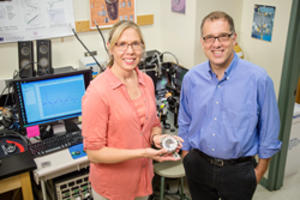Illinois professors Nancy Sottos and Andrew Gerwith developed a method to comprehensively measure the mechanical stress and strain in lithium-ion batteries. It revealed a point of stress in charging that, if addressed through new methods or materials, could lead to faster-charging batteries.
Batteries that charge faster and have greater capacity could boost portable electronic devices and electric cars. A new method to simultaneously test stress and strain in battery electrodes gives researchers a window into the mechanical, electrical and chemical forces within lithium-ion batteries. The method revealed an unexpected point of stress in the charging cycle, which could guide development of better batteries.
University of Illinois chemistry professor Andrew Gewirth, materials science and engineering professor Nancy Sottos and graduate students Elizabeth Jones and Hadi Tavassol published their work in the journal Nature Materials.
“We are finding limitations that are preventing the material from operating properly,” Gewirth said. “We are trying to understand what those limitations are and then develop materials and ways of processing materials that overcome them.”
A lithium-ion battery works by transferring lithium ions between two electrodes: the cathode and anode. When the battery is charged, lithium goes into the anode, which causes the material to expand. When the battery is discharged, the lithium leaves the anode, causing it to contract. However, because the material is constrained within the battery cell, it cannot truly expand and contract as it would when unconstrained, which causes mechanical stress within the material, Sottos said. Most methods of studying battery operation focus on electrochemistry, overlooking this mechanical response, she said.
“The relationship between the electrochemistry and the development of stress and strain is not well understood,” said Sottos. “The stress and strain can actually change the way a battery functions, and usually in a negative way – like the capacity will fade, or it will cause small cracks that cause reactions you don’t expect.”
The researchers combined two techniques to get a more holistic picture of the mechanical forces during battery charging and discharging. They measured the strain, or how much the material expands, by seeding the anode with fluorescent nanoparticles and precisely measuring their movement as the battery went through charging cycles. Meanwhile, they measured stress, or how much the material bends or buckles, using an advanced optical technique.
“There have been other ways of looking at batteries – electrochemical methods, circuit methods, techniques involving light – but no one has done a comprehensive mechanical probe the way that we have,” Gewirth said. “Stress and strain have been measured separately, but no one has even looked at them together before.”
The researchers have dubbed their holistic measurement “electrochemical stiffness,” defined as the ratio of stress to strain.
The measurement has already revealed one surprising finding: Right before the lithium is taken up by the anode, there is a spike in stress.
“We didn’t expect there would be a barrier or an impediment to the lithiation process,” Gewirth said. “First, it shows us where the impediment is for charging. Now that we know where it is, we can work on ways to fix it. Second, it gives us a better idea of how the battery actually works.”
The electrochemical stiffness measurement technique is not limited to lithium-ion batteries, the researchers say, but can be used on a wide variety of ion-battery materials. Now that they have studied the anode, they are using the technique to study the cathode, which has its own properties and behaviors, Sottos said.
“These experiments are giving insight that it’s not just an electrochemical issue; it’s a mechanical issue,“ Sottos said. “We think we are beginning to understand some of the factors that are hindering faster battery charging. We may be able to identify things that let us charge faster and have higher capacity, with less capacity fade over time.”
The Center for Electrochemical Energy Science, an Energy Frontier Research Center funded by the U.S. Department of Energy, supported this work. Sottos also is affiliated with the Beckman Institute for Advanced Science and Technology at the U. of I.
Article excerpted from a University of Illinois article by Liz Ahlberg Touchstone
Photo by L. Brian Stauffer
